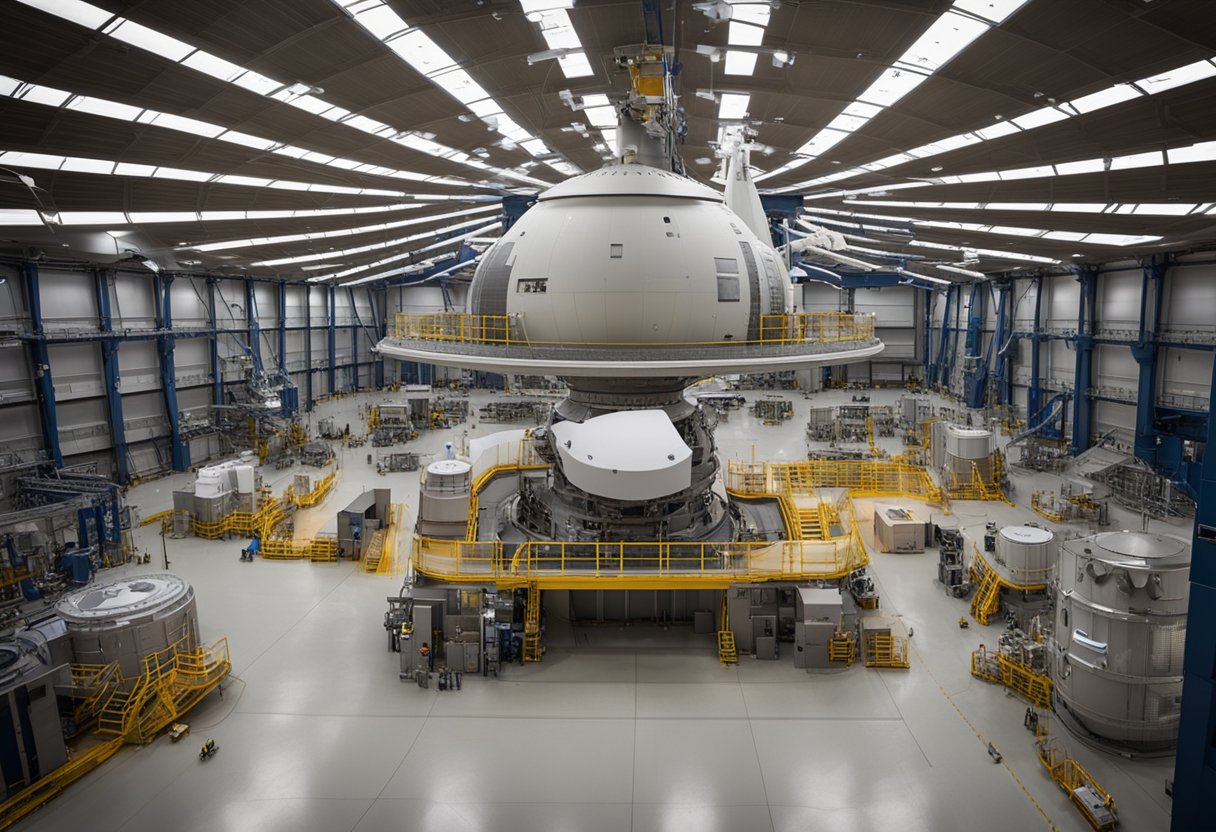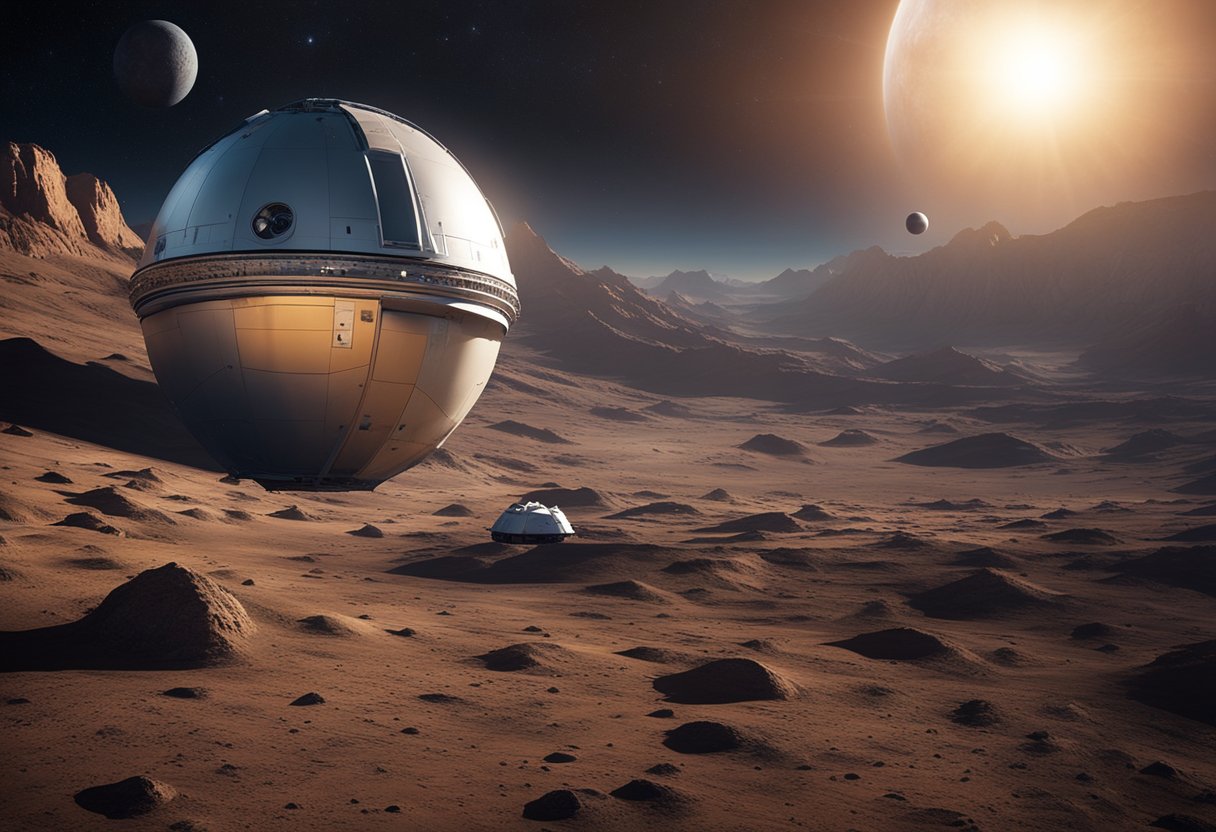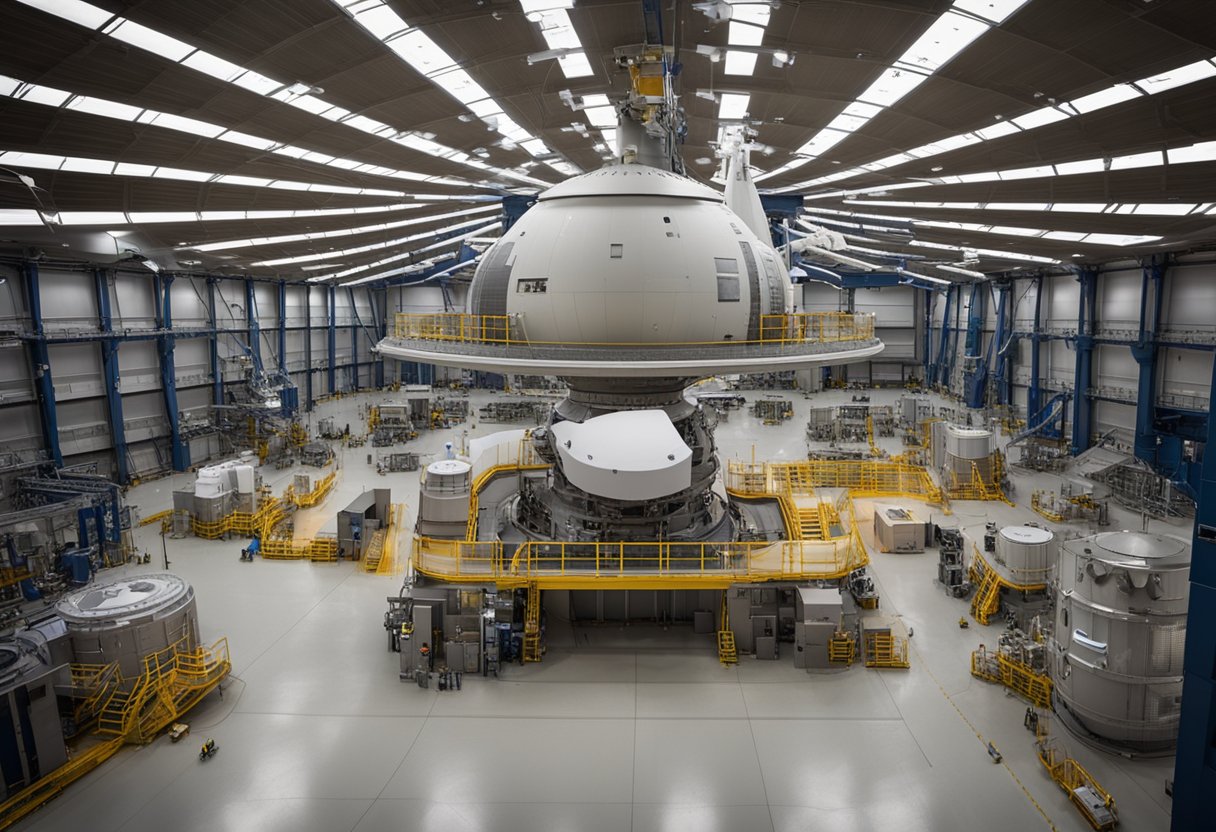
Orion Spacecraft Exploration – Exploration beyond the confines of Earth has long been a dream and a challenge for humanity. With the advent of the Orion spacecraft, our species stands on the brink of a new era in space travel. Functioning as a critical component of NASA’s Artemis missions, Orion is engineered to transport astronauts further into the cosmos than ever before, marking a significant milestone in our ongoing quest to explore the unknown. The craft embodies the pinnacle of current spacefaring technology, designed to withstand the harsh environment of deep space, from radiation shielding to life support systems.

Orion’s maiden voyage beyond low-Earth orbit heralds an exciting future for space exploration and sets the stage for upcoming missions to the Moon, Mars, and potentially other celestial bodies. The spacecraft comprises two main parts: the Crew Module, which houses the astronauts, and the Service Module, which provides vital support such as propulsion and power. Together, they form a state-of-the-art system ready to undertake the rigorous demands of deep space missions. The journeys conceived for Orion will follow carefully crafted trajectories to achieve their objectives, harnessing the power of the mighty Space Launch System to escape Earth’s gravitational hold.
The Orion spacecraft is set to redefine human space exploration with its advanced design and specification tailored for deep space missions. It serves as the pillar of NASA’s Artemis programme, aiming to return humans to the Moon and beyond.
Orion is an integral part of human space exploration efforts. Its design is focused on safety and reliability, ensuring that astronauts are well protected throughout their journey. Here are key design and specification highlights:
These components form a spacecraft that not only supports long-duration missions but also withstands the high-speed re-entry forces from deep space.
Our journey with Orion began in the early 21st century. Here’s a brief timeline:
Orion represents our commitment to extend human presence to the Moon and beyond, paving the way for future endeavours in the domain of space exploration.
As we examine the Orion Crew Module, it’s crucial to understand that this is the heart of NASA’s Orion spacecraft, designed for deep-space missions. It not only serves as the primary living quarters for the astronauts but also integrates critical safety systems.
The Orion Crew Module is equipped to sustain our astronauts with a life support system that controls the atmosphere within the capsule. It provides the necessary oxygen and maintains pressure, while removing carbon dioxide and other contaminants to ensure a habitable environment throughout the mission. The accommodations are designed with efficiency in mind, where space and resources are optimised to support the crew on their long-duration expeditions.
Concerning safety, the Module incorporates the Launch Abort System (LAS), which can swiftly propel the crew module to safety in the event of an emergency during launch or ascent. Additionally, the structure is built with multiple redundancies and robust materials to safeguard the astronauts against the variable threats of space travel, such as micrometeoroids and intense radiation. This commitment to safety underpins every aspect of the Crew Module’s design and function, setting a new standard for astronaut security.
The Orion Crew Module heralds a significant leap forward in space exploration, representing a blend of habitat and safety upon which future missions will build.
The Orion spacecraft’s journey begins with a meticulously orchestrated launch sequence followed by a critical ascent trajectory, integral to its mission’s success.
Location: Launching from the iconic Kennedy Space Centre in Florida, the Orion spacecraft embarks on its exploration missions atop the powerful Space Launch System (SLS). Timing: The launch process involves a series of precise events that must occur in a strict chronological order. These include the ignition of the rocket’s engines and the subsequent lift-off that propels Orion into space.
After liftoff, the Orion spacecraft follows an ascent trajectory, a defined path that takes it from Earth’s surface to the appropriate orbit. The trajectory is critical to ensuring the spacecraft exits the atmosphere efficiently and enters space on the correct course for its journey around the Moon or to other deep space destinations. Our design of this phase involves careful consideration of various physical and technical challenges, such as Earth’s gravitational pull and atmospheric conditions.

The service module is a critical component of the Orion spacecraft, designed to perform key supportive functions that are crucial throughout the mission’s lifecycle. It supplies propulsion, power, thermal control, and life support systems, ensuring the spacecraft and its crew can complete their explorations safely and effectively.
The service module provides propulsion capabilities required for in-space manoeuvring, maintaining orbits, and host of other critical mission activities. It is equipped with engines capable of delivering the precise thrust necessary for delicate space manoeuvres. Additionally, the module incorporates solar power systems to generate electricity to power the Orion spacecraft. These solar panels are designed to efficiently harvest solar energy, even at great distances from the Earth.
Our collaboration with the European Space Agency (ESA) has resulted in the development of the European Service Module (ESM), a pivotal aspect of the Orion service module. This partnership leverages ESA’s expertise in space engineering and enhances the module’s capabilities. The ESM provides power, water, air, and electricity, representing the primary life support system for astronauts aboard Orion. This cooperative venture highlights the importance of international collaboration in pushing the boundaries of space exploration.
As we extend our reach beyond low Earth orbit, the Orion spacecraft is pivotal for deep space exploration missions which include lunar orbit and the surface of the Moon.
The Artemis programme is a historic step in our lunar exploration. It’s built on a foundation of international cooperation, and the Orion spacecraft is crucial for its success. On these missions, Orion will be tasked with carrying a crew to space, providing emergency abort capability, and ensuring the astronauts are sustained and return safely from their deep space ventures. The first Artemis mission will see Orion fly around the Moon, testing the spacecraft’s performance in a deep space environment, anchored by the powerful Space Launch System rocket.
Our objectives for extending lunar exploration with Orion are clear and precise. We aim to establish the Artemis Base Camp concept for extended lunar stays, increase our understanding of the Moon’s resources, and test new technology essential for missions to Mars and beyond.
In these explorations, Orion will serve as a reliable vessel for transit to and from the lunar orbit, offering a platform for unprecedented scientific inquiry and the development of new spacefaring technology. Coupled with projects documented by space tourism platforms like SpaceVoyageVentures.com, these missions are not only proving grounds for future endeavours but also a glimpse into the possibilities of space travel for all.
Understanding the intricacies of the mission profiles and trajectories is pivotal for the success of our explorations. We delineate the orbital mechanics and project the journey not only to the Moon but also consider ambitions beyond.
Orion’s missions are meticulously planned to ensure safe passage for the spacecraft and its future crew. The spacecraft adapter links Orion to the rocket, facilitating a secure transit to space. Once in orbit, the adapter is jettisoned, and Orion manoeuvres to an orbit that can take it towards the Moon. The trajectory is key for achieving optimal energy use and aligning with designated mission objectives.
The orbital paths are far from simple circles or ellipses. They are shaped by the gravitational pulls of Earth and the Moon, engaging in complex routes known as Lunar Transfer Orbits or Free-Return Trajectories. These paths ensure Orion can enter and exit lunar orbit with precise control over its location and velocity. Mission planners use Artemis I as a benchmark, where the mission showcased a successful uncrewed test to orbit and return, setting the stage for subsequent crewed missions and lunar exploration.
Our Moon missions using the Orion spacecraft are stepping stones for more audacious explorations. We have concrete plans to push the boundaries towards Mars, using the Moon as a testing ground for technologies and human adaptation to deep space conditions. Our vision includes not only flags and footsteps on lunar soil but also establishing a sustainable human presence as we prepare for the Red Planet.
Orion’s trajectory to the Moon involves insertion into a Distant Retrograde Orbit (DRO), which provides a stable orbit due to the balancing gravitational forces. This stability gives us ample time for experiments, extravehicular activities, and preparations for future legs of the journey. As we master Orion’s lunar missions, we lay the groundwork for longer-duration flights that will eventually lead us to Mars. The knowledge we accumulate here informs our approach to spacecraft design, life support systems, and the crucial interplay between humans and their spacecraft amidst the unforgiving vacuum of space.
By focusing on the precise mechanics and projected destinations of our missions, we ensure that our ventures into space, documented by sites such as SpaceVoyageVentures.com, are not just the stuff of dreams but tangible realities within our grasp.
As we delve into the Orion spacecraft’s capabilities, it’s imperative to highlight the significant strides made in studying outer space environments and the sophisticated means of data collection and analysis. These elements are critical to advancing our understanding of space science and ensuring the success of long-duration space exploration missions.
One of the paramount objectives aboard Orion is to conduct research on the space environment. This pertains to the assessment of radiation levels that astronauts may encounter on their journeys beyond low Earth orbit. By understanding the intricacies of space radiation, we are able to develop more effective shielding and countermeasures to ensure the safety of the crew. This research also extends to the study of microgravity’s effects on both human physiology and various materials.
Our endeavours in space exploration heavily rely on robust data collection and analytical methods. Orion is equipped with an array of sensors and instruments designed to gather precise measurements and relay this information back to Earth for thorough analysis. These data sets provide insight into the spacecraft’s performance in the harsh conditions of deep space and underpin scientific experiments. Such comprehensive data underpins the foundation of predictive models and simulations that are vital for the planning of future missions.
By employing these advanced research mechanisms, we are expanding our scientific horizons and paving the way for future space exploration.
As we examine the Orion spacecraft’s return to Earth, the focus is on the precision of the re-entry process and the meticulous operations that ensure the safety and retrieval of the spacecraft upon splashdown.
During the re-entry phase, Orion navigates the Earth’s atmosphere at speeds upward of 28,000 miles per hour. The spacecraft is equipped with a robust heat shield, vital for withstanding temperatures reaching nearly 2,800 degrees Celsius. Our spacecraft’s entry interface begins at an altitude of 400,000 feet, with the heat shield playing a pivotal role in protecting Orion from the intense heat generated by atmospheric friction.
Splashdown is a term given to the moment Orion makes its return to the surface of the Earth, specifically into the Pacific Ocean near California. A series of parachutes deploy to decelerate Orion from approximately 300 miles per hour to a gentle and safe landing speed. Once the spacecraft has splashed down, recovery operations commence. This involves the Landing and Recovery Team who quickly and safely retrieve the Orion capsule and its crew, ensuring they are safely transported back to land.

To propel human exploration beyond the Earth’s orbit, sophisticated and large-scale infrastructure is crucial. Our focus within the Orion spacecraft exploration programme hinges on key facilities that ensure the assembly, testing, and launch of the spacecraft.
At the Kennedy Space Center in Florida, we leverage modern technology and historic launch complexes. The Neil Armstrong Operations & Checkout Building is where the Orion spacecraft’s crew module is thoroughly prepared. It is here that essential pre-flight checks and crew loading occur before the spacecraft is transported to the Vehicle Assembly Building, one of the largest buildings in the world by volume.
Crafting the intricate components of the Orion spacecraft occurs at different locations. The Michoud Assembly Facility in New Orleans plays a pivotal role in manufacturing major parts of the Orion. This is where the core elements, such as the pressure vessel, are expertly welded together. Following this, the pressure vessel is sent to Florida, where assembly progresses within the expansive confines of the Vehicle Assembly Building. This facility not only witnesses the coming together of the spacecraft but is also a testament to the precision and technical excellence required for space exploration.
In this section, we delve into the crucial challenges faced during the development of the Orion spacecraft and the notable advancements that have been made to tackle these issues.
Orion’s journey has not been without its technical challenges. Engineers have been diligently working to address issues such as the vibration forces experienced during launch, which can affect the structural integrity and function of spacecraft components. Ensuring that all systems can withstand these forces has been a priority throughout the development process. Electricity supply is another challenge, as the spacecraft requires a reliable and efficient power system to sustain its various functions in space.
Advancements in space vehicle engineering have been pivotal in addressing technical challenges. The test flight of Orion, as a part of NASA’s Artemis program, has been instrumental in understanding the spacecraft’s capabilities and limitations. Improvements have been made in the usage of materials like aluminium-lithium alloy, which offers strength and reduced weight, beneficial for the harsh conditions of space travel. Additionally, electrical systems have been refined to ensure a stable supply of power, with redundancies in place to mitigate the risk of failures.
In this section, we provide answers to common questions about the Orion spacecraft, focusing on its purpose, launch dates, notable features, mission goals, achievements, and interior design.
The Orion spacecraft is designed as NASA’s next-generation vehicle for crewed space exploration. It aims to carry astronauts beyond low Earth orbit to destinations like the Moon and, potentially, Mars.
The next planned launch for the Orion spacecraft is part of the Artemis II mission, following the uncrewed Artemis I mission. Specific launch dates have been subject to adjustments, but up-to-date information can be found on NASA’s Orion Fact Sheets.
The Orion spacecraft will be capable of supporting a crew for up to 21 days undocked and up to six months docked to another spacecraft. It is also designed to withstand re-entry speeds of 40,000 kilometres per hour and temperatures half as hot as the surface of the Sun.
Orion is integral to NASA’s Artemis program, which aims to return humans to the Moon and establish a sustainable presence there to enable future exploration of Mars. More details can be found on NASA’s Orion Overview page.
Orion has successfully flown on Exploration Flight Test-1, an uncrewed mission that tested critical systems. Further updates about past and future missions can be tracked through the Orion Blog.
The interior of the Orion spacecraft is built to be modular and adaptable to various mission needs. It is designed to maximise crew safety and functionality, featuring advanced life support systems and ample space for crew members to live and work during missions.